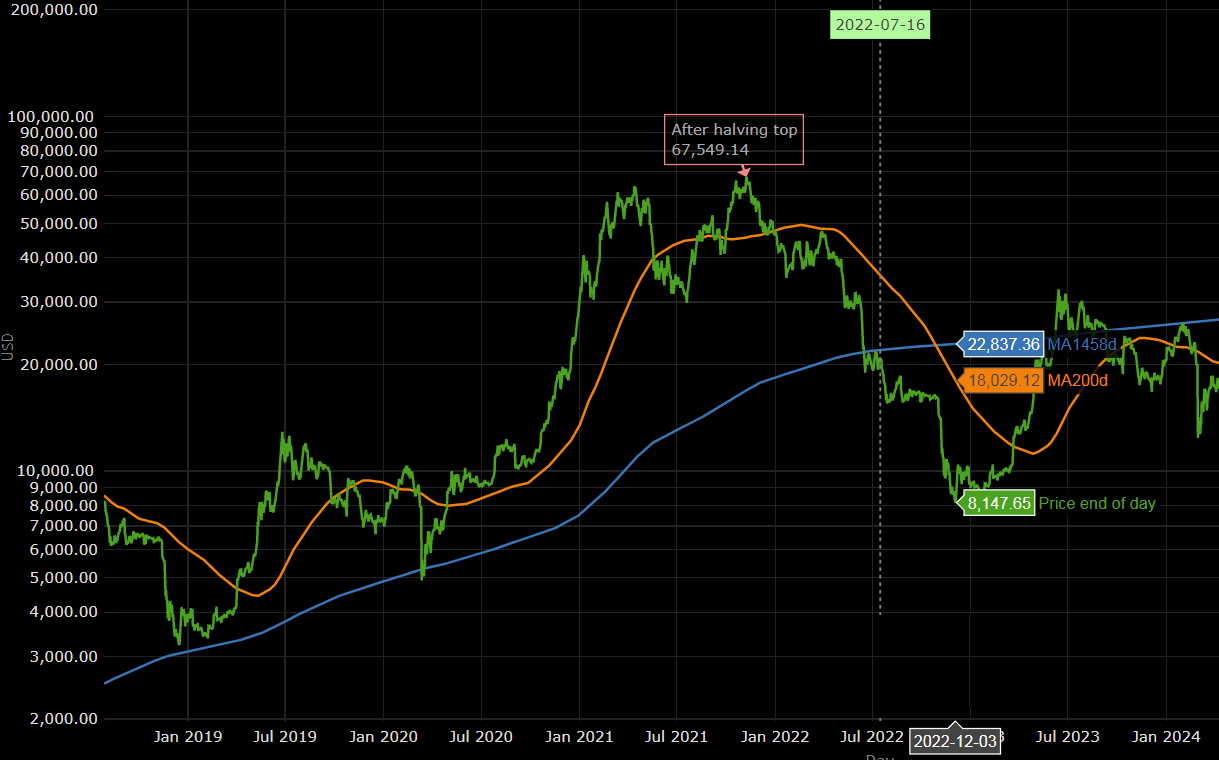Bitcoin Price To $8,000 – A New, Severe Market Collapse Is Imminent
Posted by MIKE BEN
Crypto investors appeared confident that Bitcoin would reach $100k as the euphoria stage reached its climax about one year ago.
The collapse of the Terra Luna scheme and its UST stablecoin, followed by a run on crypto custodians and crypto-VCs, was a disaster waiting to happen. As Bitcoin dropped significantly (below $20,000), it invalidated all bullish predictions and officially entered a new bust cycle.
An event that has never happened before is transpiring, with Bitcoin’s price dropping below its 2017 ATH and entering the range of its previous cycle. Is $20k the bottom (as many analysts suggest), or is there more pain for Bitcoiners?
History tends to repeat itself, and it seems it suggests that perhaps there is a lot more down before prices recover.
A historic chart predicts the worst possible scenario for Bitcoin ($BTC) for the remaining 5 months of 2022.
BTC At $8147 by December 2022

In 2017, Bitcoin’s parabolic trajectory found a peak at $20,000. Four and a half years ago, this was the end of the boom cycle for Bitcoin, and a lengthy bear market had begun by the beginning of 2018.
Yet, during that bear market (2018–2019), as with the previous one in 2014–2015, Bitcoin found a bottom at a price multiple times higher than its previous ATH.
During the current bearish cycle, BTC dropped significantly lower, entered the range of the previous 2017 cycle, reaching as low as $17600, and it seems the worst is not over yet.
According to most chart predictions, and considering the Bitcoin boom and bust cycles, there is probably another year of a bear market left before Bitcoin (BTC) and the entire crypto market recover.
While, usually, the prices tend to bounce as trading takes place, according to this chart, perhaps there won’t even be any bounce, but BTC will directly plunge to $8,150 in December 2022.
The cycle-repeat chart for Bitcoin (BTC) explains how the price will proceed if it moves in a similar course to the previous bear cycle. It predicts the price action if BTC perfectly repeats the 2018–2019 bearish cycle.

BTC’s price can capitulate and descend to $8,000 by December (this year), and it seems there is no positive indicator on the horizon to contain the downfall.
Significance

Depending on their location, miners slowly shut down hardware models (S17 ASICs), which are unprofitable at the current BTC price to operate.
The hashrate that powers and secures the BTC network will drop as miners will shut down more machinery and dump their reserves in the market to pay for their liabilities. Loans ($4 Billion backed by mining rigs that quickly lose their value (Bloomberg) will be a burden for the profitable operations of weaker miners.
Considering the scenario of a Bitcoin death spiral, a drop to $8,000 will not generate such an event as the most efficient miners will still be able to mine for a profit. Such an event would demand an abrupt price decline, perhaps at a level of 90% during the beginning of a 2016 block epoch.
However, we can’t guess what might happen if the price drops significantly lower than $8,000.
The next difficulty will drop by approximately 4% as S17 ASICs are unprofitable, with BTC at $20,000.

Certainly, a severe decline in Bitcoin’s price will recreate historic events we’ve observed in the past:
- miners filing for bankruptcy,
- hardware (ASICs) thrown out of their facilities and sold for scrap,
- blocktime will increase significantly (hours for each block) until difficulty readjusts to a lower number.
We’ve already experienced all these events before, and usually, they present a bottom signal, an indicator experienced traders realize as “blood in the street.”
Considering the risk and reward for a speculative asset such as Bitcoin (BTC), the smart money will slowly buy this dip which they waited for so long.
Certain issues could stop Bitcoin (BTC) from entering a new bullish cycle, though.
One is Tether, which has to worry about the new EU stablecoin compliance regulations.
Moreover, we should expect fierce competition between CBDCs and cryptocurrencies in the coming years.
Although, it could just be one-sided since governments can simply ban cryptocurrencies as a method to support their centralized version of digital cash and monopolize digital payments.
While regional regulations will not present an immediate threat to the viability of decentralized cryptocurrencies (the networks will always keep running), the magnitude of economies like the US and EU is essential when considering cryptocurrencies under the prism of investing.
Extreme regulations or even a blanket ban on crypto payments or mining are threats to the sustainability of the current prices and could prevent a new “bull run” after the fourth Bitcoin (BTC) halving.
The Worst Is Yet To Come
Due to the cryptocurrency exchange mechanisms, the price of BTC is influencing the rest of the market. The BTC trades and the trading algorithms used by “whales” have tethered every cryptocurrency asset to the price action and volatility of BTC, with a few differences between each.
While examining the historic price action of cryptocurrencies, we can’t ignore the boom and bust cycles generated by the Bitcoin (BTC) halvings. There have been three (major) bullish cycles, and we are currently experiencing the third bearish one.
History is not repeated precisely but usually with minor (or substantial) differences. This market is programmed to operate like that due to the halving events of its (current) driving force, Bitcoin (BTC), thus investors should act according to the boom and bust criteria.
Speculatively exploit it undertaking risks when the signs are predominantly deceiving.
This article covers a possible price scenario for Bitcoin, but the future is uncertain, and price predictions are never accurate. We establish our predictions on a vision of a possible future, but multiple more variables contribute to price volatility in the crypto markets.
Published @ https://medium.com/the-capital/warning-bitcoins-price-is-about-to-crash-to-8-000-1965fc3cdc8a
TAGS:



